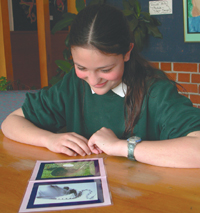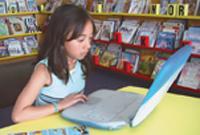New Zealand’s
National Education Monitoring Project commenced in 1993, with the
task of assessing and reporting on the achievement of New Zealand
primary school children in all areas of the school curriculum. Children
are assessed at two class levels: Year 4 (halfway through primary
education) and Year 8 (at the end of primary education). Different
curriculum areas and skills are assessed each year, over a four year
cycle. In 2001, the areas covered were information skills, social
studies and mathematics.
The main goal of national monitoring is to provide detailed information
about what children can do so that patterns of performance can be
recognised, successes celebrated, and desirable changes to educational
practices and resources identified and implemented.
Each year, small random samples of children are selected nationally,
then assessed in their own schools by teachers specially seconded
and trained for this work. Task instructions are given orally by teachers,
through video presentations, on laptop computers, or in writing. Many
of the assessment tasks involve the children in the use of equipment
and supplies. Their responses are presented orally, by demonstration,
in writing, in computer files, or through submission of other physical
products. Many of the responses are recorded on videotape for subsequent
analysis.
This report focuses solely on year 8 students. Starting in 1999, assessments
of students learning in Mäori immersion programmes were added
to the national monitoring programme, at the year 8 level only. In
2001, about 60 percent of these Mäori immersion students were
learning in immersion schools (mainly Kura Kaupapa Mäori), while
the other 40 percent were learning in immersion classes (located in
mainstream schools, but having 80 to 100 percent of instruction conducted
in Mäori). For this special sample of students learning predominantly
in Mäori, the assessment tasks and task materials were translated
into Mäori and administered by teachers experienced in Mäori
immersion settings. The results these students achieved are reported
here, together with comparative figures for Mäori students in
the main year 8 national monitoring sample (whose schooling was conducted
predominantly in English).
Chapter 1 explains key features
of the National Education Monitoring Project that are relevant to
this report.
Chapter 2 explains some issues
affecting the interpretation of the assessments in Mäori immersion
settings, and especially the comparisons of the achievements of Mäori
students in general education and Mäori immersion programmes.
One issue involved the translation of task instructions and materials
from English to Mäori. While this was done with considerable
care by a team of seven experienced people, some of the resulting
translations used vocabulary or language structures that would not
have been easy for all immersion students to understand. To some extent
this is exacerbated because the various Mäori curriculum documents
are quite new, but it will always remain a challenge to find natural
language in both English and Mäori that communicates exactly
the same task requirements.
A related issue is that some of the students in Mäori immersion
settings had not yet developed sufficient skills in Te Reo Mäori
to fully understand task instructions or to communicate their responses
well. The selected Mäori immersion schools were asked to indicate
which of their students had completed more than four years of immersion
education, and national monitoring samples were selected from these
experienced students. Nevertheless, some of the selected students
still struggled at times with communication in Mäori.
Other important issues affecting interpretation of the results are
the different curriculum emphases in Mäori immersion schools
and classes and the often limited availability of suitable resources
for their teaching and learning programmes. Because curriculum priorities
are different for Mäori immersion education than for general
education, patterns of achievement can be expected to differ accordingly.
Also, Mäori immersion education is in an early stage of development.
Many immersion schools and classes have been established for only
a few years. Teaching and learning resources in Te Reo Mäori
are scarce, as are teachers with suitable expertise. High levels of
teacher, parent and student commitment help to compensate for these
obstacles to successful learning, but further improvement can be anticipated
as Mäori immersion education grows and consolidates.
|
CHAPTER 3 : INFORMATION SKILLS |
Chapter 3 presents results of the assessments of students’
information skills. Students possessing well developed information
skills can
 |
 |
|
perform three
main tasks effectively: clarifying information needs, finding and
gathering relevant information, and then analysing and using that
information to meet the required purposes. A substantial proportion
of the intellectual demands occur during the first and third of
these tasks: finding and gathering information is clearly important,
but its value is greatly dependent on the extent to which it can
be validly interpreted and used to meet information needs.
Fourteen information skills tasks were administered to individual
Mäori students in both general education and Mäori immersion
settings. Four of these tasks were judged to be unsuitable for comparisons
of the performance of the two groups of students, for reasons explained
in the task commentaries. Among the remaining ten tasks, Mäori
students in general education and students in Mäori immersion
settings performed equally well on four tasks, while Mäori students
in general education scored statistically significantly higher on
six tasks.
|
CHAPTER 4 : SOCIAL STUDIES |
Chapter 4 presents results
of the assessments of students’ knowledge, understanding and
skills in social studies. The stated aim of social studies education
is to enable students to participate in a changing society as informed,
confident and responsible citizens. To help achieve this outcome,
students are expected to acquire knowledge that will inform and contribute
towards their understandings about responsibilities, relationships,
culture, heritage and management of the environment and resources.
They are also expected to develop the skills needed to live and contribute
as effective and worthy members of society.
Twenty-five social
studies tasks were administered to individual Mäori students
in both general education and Mäori immersion settings. Two of
these tasks were judged unsuitable for comparisons of the performance
of the two groups of students. Among the remaining twenty-three tasks,
Mäori students in general education and students in Mäori
immersion settings performed equally well on twelve tasks. Students
in Mäori immersion settings scored statistically significantly
higher than Mäori students in general education on six tasks,
while Mäori students in general education scored statistically
significantly higher than students in Mäori immersion settings
on five tasks.
 |
 |
| |
Chapter
5 presents the results of the assessments of students’ knowledge,
understanding
and skills in mathematics. Conceptual understanding is a central goal
of mathematics education. Mathematics education is very much concerned
with such matters as students’ confidence, interest and inventiveness
in working with a range of mathematical ideas. It aims to help students
develop their capacity for exploring, applying and communicating their
mathematical understandings within real-world contexts. While confidence
and efficiency in basic knowledge of facts is important, a substantial
focus is also placed on thinking, reasoning and problem-solving skills,
requiring more open tasks that allow students to demonstrate their
number sense, reason, make decisions and explain.
Sixty-three mathematics tasks were administered to individual Mäori
students in both general education and Mäori immersion settings.
Five of these tasks were judged to be not suitable for comparisons
of the performance of the two groups of students. Among the remaining
fifty-eight tasks, Mäori students in general education and students
in Mäori immersion settings performed equally well on thirty-four
of the tasks, while Mäori students in general education scored
statistically significantly higher on the remaining twenty-four tasks.
These higher scores occurred on 30 percent of the tasks in the Number
strand, 42 percent of the tasks in the Measurement strand, and 52
percent of the tasks in the remaining strands (Geometry, Algebra and
Statistics).
Chapter 6 reports the results of surveys
of students about their curriculum preferences and their perceptions
of their achievement and potential in information skills, social studies
and mathematics.
Physical education was the most popular of twelve subjects, for both
groups. For Mäori students in general education, art came next,
followed fairly closely by technology and more distantly by mathematics
and music, then Mäori and science. Students in Mäori immersion
settings placed mathematics much higher, just ahead of art, with only
Mäori and technology showing substantial popularity among the
other subjects. Social studies came lower for both groups, but this
may be misleading because social studies is often embedded in theme
work and not easily identified as social studies.
The Information skills survey showed that, compared to Mäori
students in general education, the students in Mäori immersion
settings were much less likely to try to find information in a library
and somewhat less likely to search on the Internet. Conversely, they
were much more likely to ask a friend, teacher or parent. They were
substantially less likely to have used a computer catalogue, probably
reflecting the limited availability of fiction and non-fiction books
in the Mäori language. The students in Mäori immersion settings
indicated that they more frequently had really interesting studies
to find information for, were more positive about hunting for information
and their ability to do so, and also were more positive about sharing
their information with others or writing it down. More than half indicated
that they voluntarily looked for information “heaps” or
“quite a lot”, compared to only 25 percent of Mäori
students in general education.
The social studies
survey showed that, compared to Mäori students in general education,
students in Mäori immersion settings were much more positive
about doing social studies at school, doing more social studies at
school, and learning or doing more social studies as they got older.
In response to questions about eight different aspects of social studies
education, Mäori students in general education were particularly
interested to learn about “living in the future”, with
67 percent choosing the highest rating, but four of the other seven
aspects had more than 30 percent of students choosing the highest
rating. Students in Mäori immersion settings were even more positive,
with more than 30 percent of students choosing the highest rating
on six of the eight aspects. Compared to Mäori students in general
education, students in Mäori immersion settings were substantially
more positive about two aspects (the way people work together and
do things in groups, and the work people do and how they make a living),
and substantially less positive about one aspect (how people lived
in the olden days). When asked to rate how often they learned about
each aspect in social studies at school, students in Mäori immersion
settings generally gave higher ratings, with seven of the eight aspects
having more than 50 percent of students using the ratings “heaps”
and “quite a lot”, compared to just two aspects for Mäori
students in general education.
The mathematics survey also revealed some interesting differences
between the two groups. Asked about mathematics class activities,
students in Mäori immersion settings were much more enthusiastic
than their general education counterparts about doing maths tests,
taking parts in maths competitions, and working in their maths book,
but dramatically less enthusiastic about working on maths problems
and puzzles. They generally placed much more emphasis on learning
basic facts and tables. Their responses to 11 rating items indicated
that they were much keener to do increased amounts of maths at school,
and enjoyed doing maths at school substantially more. They also were
more positive about their own capabilities in maths and about how
good their teachers and their parents thought they were at maths.



